This is a glorified summary with some analysis… loads of spoilers… Turn back now if this is not your thing!
Tale of Tales is a 2015 film by Matteo Garrone whose previous claim to fame is the gritty crime drama Gomorrah (2008) that won the Grand Prix at the 2008 Cannes Film Festival. The film is a dark tale of three tangentially connected narratives full of fairytale logic of impossible tasks and dark magic, princesses to be married off and obsessive queens.
Told in the same style as the bloody and pornographic rewrites of classic fairytales in Angela Carter’s Bloody Chamber, this film is brutal and unforgiving in its treatment of female characters. It punishes them in bloody and extreme ways for failing to break out of the roles created for them by the patriarchy: Maiden/ Virgin Bride/ Princess/ Daughter/ Mother/ Queen.
Tale 1: Queen Mother
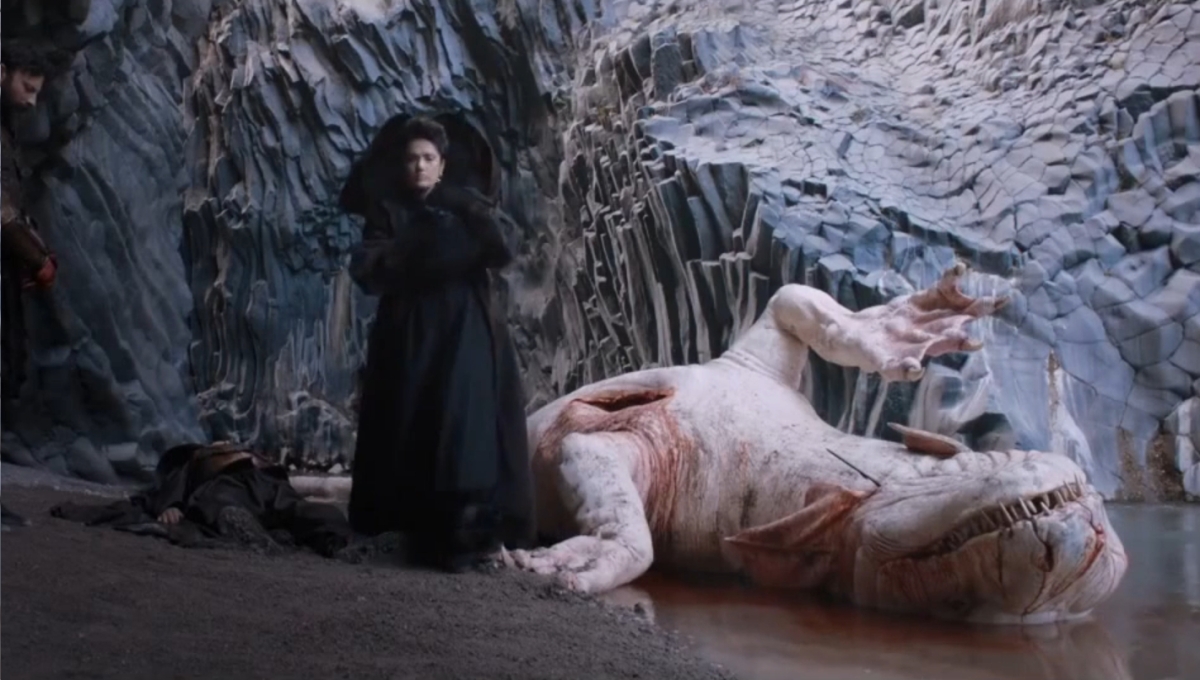
Obsessed with motherhood, the Queen of Longtrellis will do anything to have a child. In typical fairytale fashion that elides the need for dick-measuring to prove virility, the king is sent to slay a sea monster. The overall maleness of the hunt – that is full of phallic imagery from the harpoon used by the King, who is himself representative of the patriarchy, to the long, white water dragon that eviscerates the king with its tail in the ensuing struggle – is concentrated in the heart of the beast that must now be cooked by a virgin and eaten by the Queen.
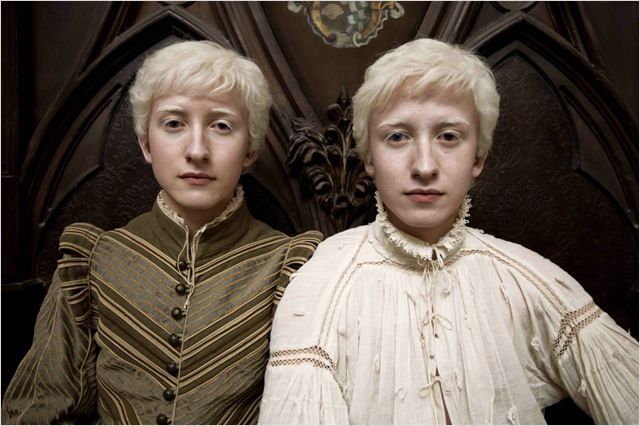
But so potent is the symbolism concentrated in the heart that not one but two children are begotten from this impossible task – twin albino boys from two different mothers, one by the scullery maid who inhales the fumes from cooking the sea monster’s heart, and the other by the queen who eats the heart.
Once she has her son, she guards him jealously, so much so that instead of reaching out to the other woman who has been affected by her quest for a child, the Queen threatens to kick her out of the kingdom when she sees the servant’s boy as a rival for her son’s affection. In the end, she is so defined by her role as mother to her son that she pays for it with her life in her final attempt to separate the boys.
Tale 2: Ancient Sister Dora and Imma
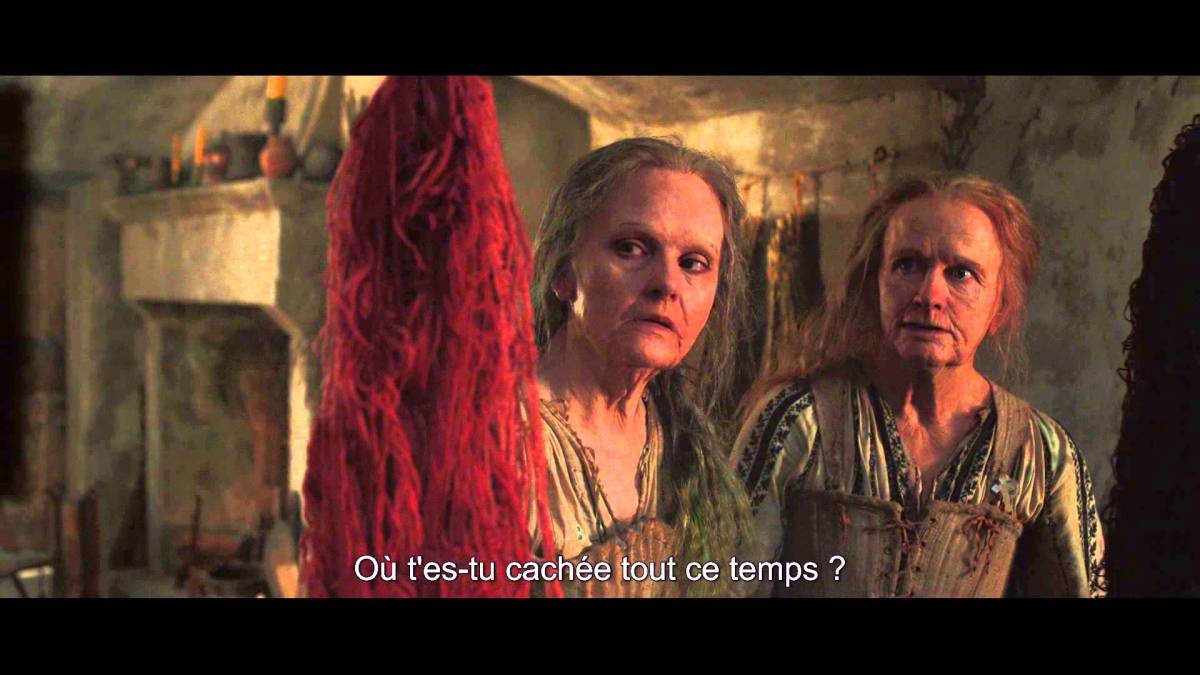
In this tale, a pair of elderly sisters, Dora and Imma, attract the attention of a lustful but ruthless king who overhears Imma singing. Her dulcet tone belies her wizened flesh and fearful of being accused of deceiving the king who expects to see a beautiful broad attached to that voice, allows her sister Dora to set up the familiar body swap premise seen in other tales such as Shakespeare’s Measure for Measure. Dora agrees to come to the king’s bed chambers under the cover of darkness and under the condition that there be no lighted candles in the room. But she oversleeps and when the king discovers her aged body next to his in the morning light he has her defenestrated. Fortunately, instead of falling to her death, she meets a witch who breast feeds her and turns her into a young woman again with the reminder that ‘this too shall pass.’
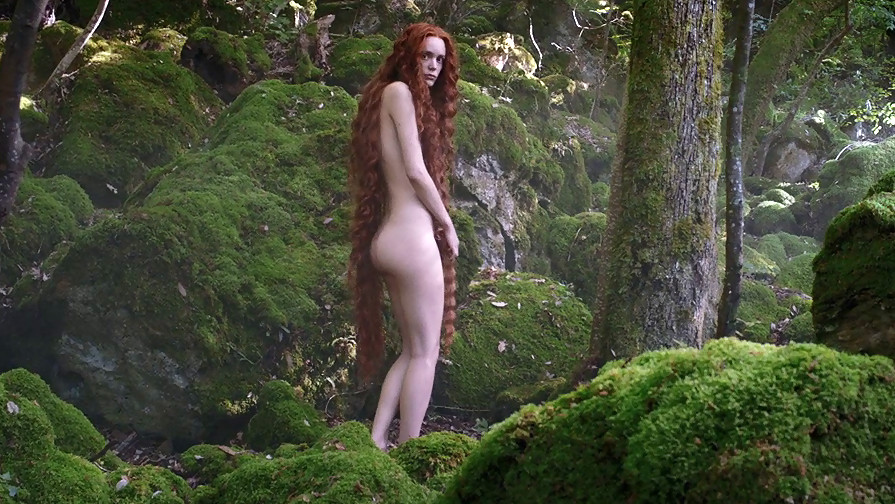
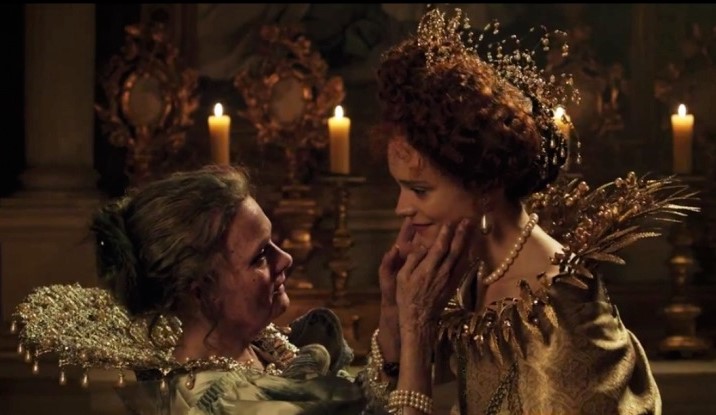
Imma, upon seeing Dora at her royal wedding to the king, desirous of her young flesh asks her how she came to be young again. Petty Dora, unwilling to share the secret of her sudden youth with her sister, replies cuttingly that she had herself flayed and her skin grew back younger. Imma, taking her sister’s word at face value, pays to have herself flayed. The film pulls no punches in this as we see her return to the castle with her blood soaking through her clothes, and her face a bloody mess.
The interesting treatment of flesh and skin this tale with the display of old flesh, the stretching and pulling of it to make it look younger, the breastfeeding of an old body cradled as one would a newborn brings to the fore the simple – and what should be obvious – understanding that young flesh gives way to old flesh and that when you marry the maiden you have also married the crone. These are not separate entities and because the sisters forget this and are consumed by their desire to recapture their youth, because they’re not comfortable in their own skin, they are punished for it – Imma voluntarily allows herself to be flayed and Dora begins to rapidly revert to her original age by the end of the film.
Tale 3: Princess Violet
Daughter to a king who has about as much interest in her as he would a flea, Violet allows herself to be married off to the first suitor who is able to solve her father’s impossible riddle. So arrogant and self-assured is the patriarch in the impossibility of his own riddle that he believes his daughter will either never be married off or only married off to the most intelligent of gentleman callers. Alas! When an ogre that sells furs for a living identifies the mysterious pelt correctly, both king and princess are forced to honor his proclamation (because the word of the patriarch is law).
This tale was the most compelling for me because the ogre doesn’t speak and vacillates between brutish behaviour and seeming kindness. He offers to carry the princess, who is emotionally and physically exhausted from her ordeal, on his back on their journey back to his cave. His awkward attempts to win her favor by clearing a space in his dwelling for her and offering her an uncooked leg of mystery animal is also oddly endearing but ultimately undercut when he forces her into their marital bed and rapes her.
The pacing in a later sequence in this tale also expertly plays with convention and viewer expectations. In this sequence, Violet manages to escape with the help of some carnival folk. She first attracts the attention of a woman on a neighbouring cliff who then promises to come back the next day, stating explicitly that she will get her sons to help rescue Violet. When a handsome, dark-haired youth shows up the next day to carry Violet across a tightrope strung up and connecting the two cliffs, we’re encouraged to think that Violet will finally be saved. Of course the ogre discovers she has gone missing and rushes out to see the youth halfway across the tightrope with his bride. He follows them in typical fairytale fashion by throwing himself onto the tightrope as well. As soon as the youth reaches the other side the father is ready with a knife to cut the rope and the ogre falls into the chasm between the two cliffs.
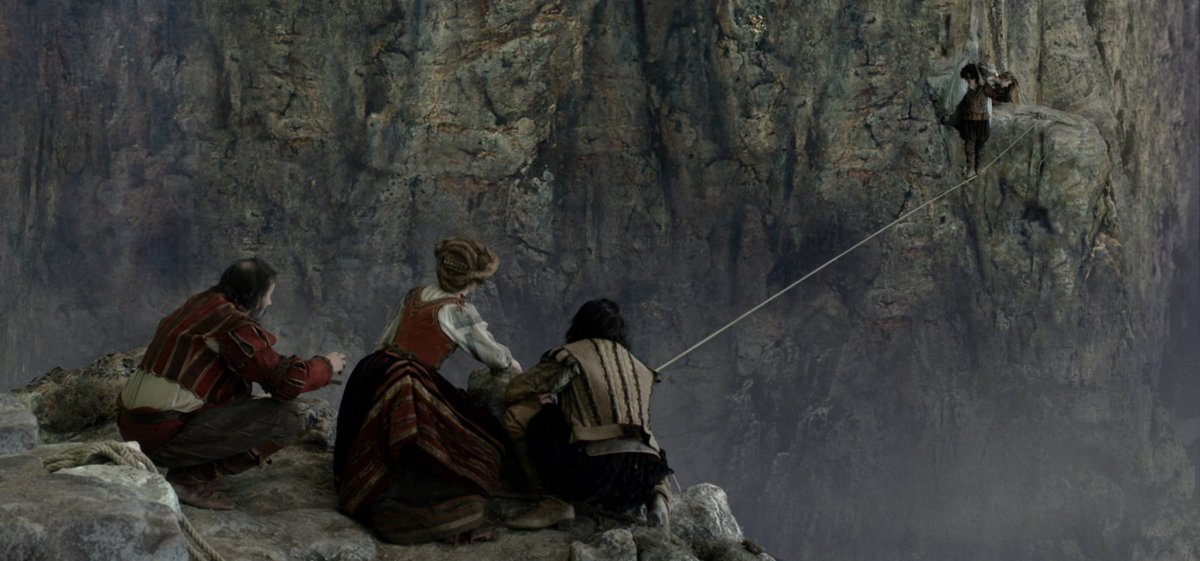
The thing about this sequence is that it is satisfying in the way it seems to fulfill a kind of internal checklist that puts audiences at ease. The damsel in distress is saved, and the monster is slain, the ogre’s fall to his death even recalls other fairytales like Jack and the Beanstalk. The requisite struggle also adds to the scene by helping the hero to appear brave, skilled and therefore worthy of the princess’ future affections. A ‘Happily Ever After’ seems imminent and the tension in the audience starts to unwind.
So the audience is caught completely unprepared when the ogre bursts back onto the scene later on killing the entire family of carnival folk in record time – snapping necks and beating the sons into a bloody pulp. Violet runs, but when she realizes she can’t outrun her husband, she crouches down to cry. When the ogre finds her, they share long stares and what seems to be a tender moment before he offers her his back again so he can carry her back to their cave. But instead of bringing her hand up to anchor herself around his neck, she slices his neck open.
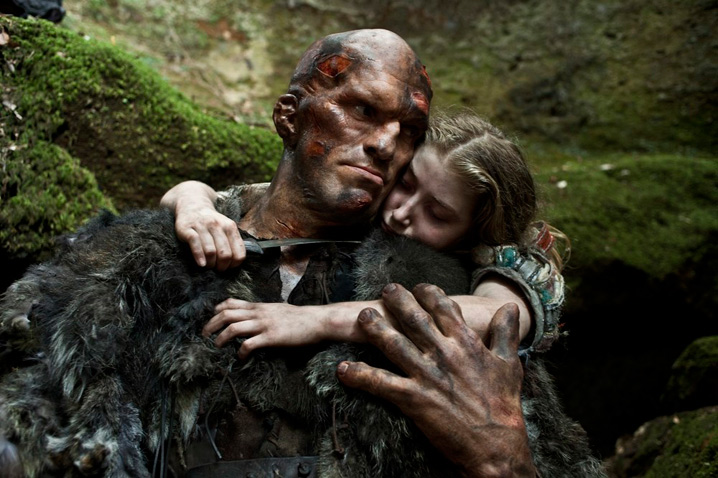
I thought the sudden return of the monster was really effective because of how it upended narrative conventions and audience expectations. And to do it twice in such a short span of time was even more impressive because, perhaps it’s just me but because so much of the exchange between Violet and her husband was done without words, I had to make sense of the stares they were sharing and the meaning of the tender moment they had right before she kills him. And for a moment I actually caught myself thinking that, maybe he thought she had been kidnapped instead of having chosen to run away? Maybe that’s why he killed that whole family of carnival folk?
But when she sliced open his neck I was reminded that this is also the man who raped her and that I’d just been trying to rationalize his actions the way a woman caught in an abusive relationship suffering from Stockholm Syndrome might try to rationalize or romanticize her captor’s actions. Creepy. Creepy but effective.
It just made me realize how strong the pull and desire for a happy ending is that we’d take any man, even a monster, in order to reach that end.
I’m not entirely sure if this is the doing of the film or just my own, highly solipsistic reaction to what was happening on screen, but one thing was definitely clear about the character and about the film’s message – Violet wasn’t getting out of this abusive relationship by relying on anyone else other than herself. And the way to do that was not to fight the monster head on, or to live by someone else’s rules, but to use those rules to her advantage like when she plays the submissive wife to get the monster to turn his back so she could slit his throat.
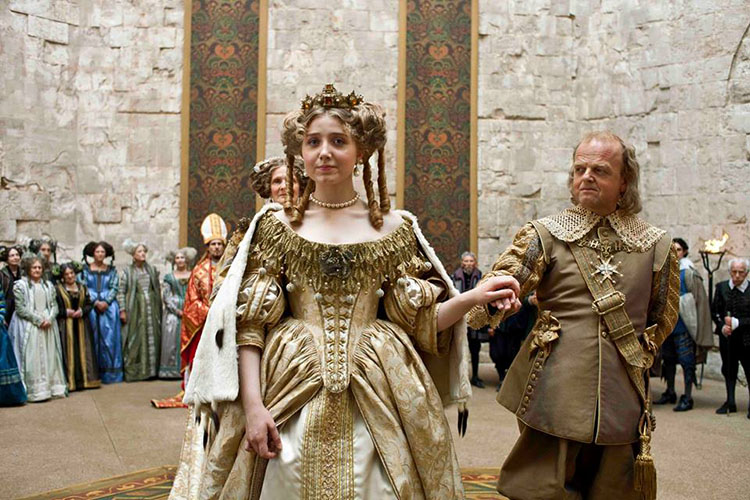
Her understanding of the need to straddle the roles given to women and to make these roles her own is probably why of the three tales, hers is the one that ends the best with her returning to her father’s kingdom and being crowned the next monarch. The balancing act she’ll have to do for the rest of her life is also probably why the film closes with the image of the tightrope walker.
Final Comments:
I was initially a little uncomfortable at the end of the film and I had to sit a while and wonder what I had just watched. Clearly, gender was a big part of it but what was the message in the film? Was it a feminist text? Why were so many women hurt, bloodied and bleeding throughout the course of the film? What was I supporting by watching this film and enjoying the beautiful effects, costumes, set designs, and cinematography? But slowly I came to the understanding that the unpleasure and the discomfort I felt watching the film is a good thing and that the flayed, bloodied and dying female bodies onscreen were a reminder of what not to be.
I suppose it’s good timing that I caught this film just after finishing my Film Theory Final Paper which is also on a similar topic so Angela Carter is still fresh in my mind and that really helped me to come to a sound reading of the film. (If you’re interested to find out more about the Film Theory Final Paper click the link ;))
And I’m glad that along with Martyrs (2008), I now have another example of a flayed woman in film! I’m glad it’s not taboo anymore to take our skin off in film whenever we need to to remind ourselves that beauty and value for a woman is more than skin deep.

Only just watched this movie and loved it. Your analysis is great! You hit all the main points and helped me get a better understanding of the themes behind the movie too. I also had the same reaction the moment before the ogre gets slain, I was sympathetic towards him for all of a minute, until I also remembered he had raped her.
LikeLiked by 1 person
Very interesting insight on battered women. I’ve read Angela Carter, but I like Tanith Lee’s Red As Blood collection much better.
LikeLiked by 1 person
So, is everything just a matter of ‘gender’ and ‘patriarchy’ to you? Is that really all you were able to see in this film?
LikeLiked by 1 person
No. The film can definitely be read in more ways than that. We could look at it in terms of narrative firms, storytelling methods. Gender was just one way and the most coherent one I could come up with at the time. It’s certainly not the only way to read the film.
LikeLike
Wow. Thank you for your analysis. I just watched this film and after it finished I just sat on my couch for hours wondering what the hell I just watched. I know it’s meant to be like Grimm fairytales in the sense that the stories do not end up how we’d want or predict in a happily ever after scenario. I just… I just didn’t understand why the women in the first two tales were so blind to their futures if they continued that self involved behavior… The last story with the young girl who was forced to marry an ogre was the most compelling because she actually overcame a situation she didn’t put herself into and she was never blind about her father, the Kings, actions might ultimately lead to her distruction. I never thought of the movie in terms of the patriarchy and how women are the center of each of these stories and what their actions and trauma means. I don’t think it was the film makers intent or at least he didn’t make it that obvious to viewers so I’m glad you picked up on these themes and shared it.
LikeLiked by 1 person
Thank you for your kind words. They will certainly motivate me to continue analysing film 😀
LikeLike
We should always look up such movies’s backgrounds first to try to understand them. It’s extremely relevant to know that this movie’s based on collections of tales (called Pentamerone or ‘Tale of Tales’, by Giambattista Basile) from the 1630s, so several CENTURIES ago. Even before the Brothers Grimm were born (well the Grimms didn’t write any stories anyway, they were just collectors and publishers).
The Tale of Tales collection also contains the original versions of Rapunzel, Sleeping Beauty and Cinderella and are considered the first fairy tales ever.
My point is that can’t analyze these stories with today’s eyes.
LikeLike
I was surprisingly shocked that I indulged and really liked this movie. The three stories aligning in the end sending of message of taking problems head on “ones day at a time”. The adult version on fairy tales with a twist. Mother’s can be overprotective and will do whatever to feel like she has to keep her young child near no matter their child’s age or the choices they want to make for ones self with utter redemption.Mother scarfing till the end to bring her son home and to part him from anything that she feels he loves more than her. The two elderly sister both longing to be young again(with one having that urning granted).Both forgetting beauty’s only skin deep. One returning back to her elderly self and the other being flayed.Last not but not least that young lady who was married off to an orger. The man raped this girl every night she was with him In the end she decided to use what she knows and has. Slicing the neck of orger and returning home to be crowned king. She will forever be undeterred or scared to face life since organically that’s all she wanted. Great movie all around great cast. Well done my friend!
LikeLiked by 1 person
The ogre wasn’t a monster and Violet was the abuser in this relationship. She made it a toxic relationship and he paid for it with his life. She was a spoiled brat that would rather kill herself at first than give an ugly guy a chance. He was too ugly, too out of what she wanted to ever give him a chance. He even carried her and protects her on the cliff. Why is he a monster but the beast from Beauty and the Beast is so wonderful? He never hit her or was aggressive toward her.. immediately trying to feed her and make her comfortable. She never even tried. This is what she wanted. She wanted a husband so badly and she never even tried to get to know him.
He was everything her father promised. Strong, courageous, smart as well as loving and a provider. He just wasn’t handsome which apparently makes him a monster.
He was the victim of this story. She was the toxic one. Not only that, but that whole circus family died to save her from her own whims. She didn’t even give a shit about them either.
And before anyone says he raped her, she is a Medieval princess. Women were property then and he has every right to his winnings, his wife. Very few men marry and don’t expect to immediately start having sex. Even in this day and age. He didn’t immediately grab her after climbing up either he gave her a chance to get comfortable to come to him and she hides away in a corner like a loser, refusing to give him a chance because he was ugly. She wouldn’t have given the manatee guy any struggle getting into his bed because it fit her whims. She’s the most unlikable character in this story.
LikeLike